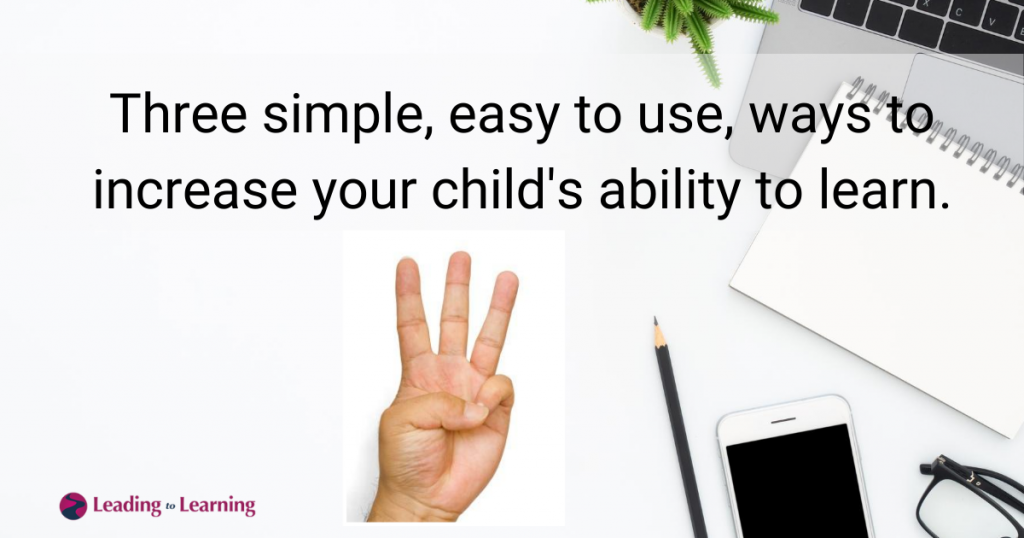The summer is here. The pressure of on-line learning has either disappeared or lessened. Now is the perfect time to set the scene for learning – to do the things that increase your child’s learning ability so that he or she is ready for school. (In BC where I live schools are going back in September).
You have four weeks to set up a simple system that you can use for a few minutes every day and incorporate into your everyday life – no extra training or resources required!
Even if your child is not going to school you can use these ways of increasing your child’s learning ability so that he or she is ready to learn either on-line or from tutors.
I am writing this mainly for parents of elementary aged schoolchildren but it also has tremendous relevance for parents with children in high school.
As many of you know I believe in two things (supported by research – no fake news here!) – the power of parents to make a difference in their child’s learning lives and that every child needs the foundational skills that are the basis of all learning.
These three strategies fit with both of these beliefs as well as fulfilling my commitment to provide parents with simple, practical, proven strategies that make a difference in their child’s learning lives.
Don’t be put off by the simplicity of these strategies. They have been used, either consciously or unconsciously, for thousands of years. Why? Because they set the scene for learning. They help children develop the skills they need to be able to learn. Once a child has these skills he or she can learn anything, anytime, anywhere.
That is how important they are. When children do not develop these skills or do not develop all of them they become underachievers. I will write more about underachievers in my next post. Trust me, you will want to know if your child is underachieving so you can do something about it.
Here are the three simple ways you can help your child develop the learning strategies that lead to success in school.
I call them The Three S’s.
- SHOW
This is by far the most important of these strategies and the easiest to implement.
Your child loves you and wants to be like you. (I am not sure about teenagers here! They are busy working out their own identities.)
Another word for SHOW is modelling. Modelling is what happens when you show someone something that you do. Think of modelling in relation to clothes. The models show the audience the clothes the designer has created – and everyone goes Ooh and Aah and takes from the show ideas for their own wardrobe.
Modelling is tremendously influential and effective.
You can make modelling work for you and your child by relating it to learning. When your child sees you modelling learning he or she will absorb the importance of learning – after all you re spending time dong it so it must be worth doing! – and also strategies that help him or her learn how to learn.
Powerful stuff!
So how do you model learning? Here are some ideas.
- Read and let your child see you reading.
- Learn something and let your child see you learning
- Write lists – either shopping lists or to do lists – and tell your child how you are organizing the list
- Plan a trip and discuss options with your child. (It could be a food shopping trip)
- Watch the news and comment of what you have learned. (Try to keep it positive!)
These are just a few ideas. As well as modelling learning you can model what you have learned. This leads to the second ‘S’.
- SHARE
You have had a lifetime of experience and learning. You have gained skills that you may not even recognize. When you share these skills with your child you are helping him or her develop the foundational skills that lead to learning.
Some of the skills you share could be very important to your child’s future. It is no secret that I could knit almost before I could walk! I lived in Yorkshire and everyone was knitting – both men and women. This skill helped me pay my way through college. I sold scarves and mittens to fellow students and made enough cash to help me enjoy a great social life!
Some skills may not be so useful. Because my father rode a motor bike to work and did all the maintenance himself I know how change a tire on a motor bike!! This has not proved to be too useful in my life I must admit but it did teach me about what I didn’t want to do ever again!
You never know which skills you share will be useful to your child. This is not your decision to take. All you can do is to make sure that you help your child learn by sharing your skills.
Here are some skills you could share
- A second language
- Cooking and shopping skills
- Cultural events
- Makeup skills
- Sewing skills
- Reading skills
- Painting/drawing skills
- Exercise skills/team sports
- The list goes on….
These two ways of helping your child develop learning skills can be done without much thought or planning.
The third way to help takes a little more thought and practice.
- SAY
Whatever you say to your child either helps or prevents your child learning.
You need to read that sentence again! Everything you say to your child effects his or her ability to learn. Everything!
There are many ways to talk to your child that increases his or her learning but the most important one is to use open questions.
There are ‘closed’ and ‘open’ ways to ask questions.
Closed questions can be answered with one or two words. They are useful for getting simple information but do not require your child to think (unless they are thinking up excuses!).
Examples of closed questions are –
- Have you done your homework?
- Are you hungry?
- What day is it?
- Are you ready?
- What is that?
All these questions and many similar ones can be answered with one or two words.
Open questions require your child to think before giving an answer. They require your child’s brain to work and strengthen the connections that improve learning ability.
Examples of open questions are –
- Why did you do that?
- How do you know that is right?
- What will you do next? Why?
- How can you do that?
- Tell me where you are going to start?
- What did you like most in school today?
- And my favourite-
- That’s right but how do you know it’s right?
Next steps.
Now you know the three ways to help your child learn think about how and when you will use these strategies. What time of day are you and your child going to be together? What skills are you willing to share with your child? What skills will your partner share?
Choose one action to try each day.
When you ask your child a closed question – as you will – try to think how you could ask it in a more open way next time. Don’t get stressed about this. It is a skill that you will develop gradually – just like your child develops skills. You might want to share this journey with your child and ask for feedback on your progress!
For those of you who – like me – are Picture Smart learners here is a link to some short videos I have made about this.
https://www.youtube.com/watch?v=Iss6zo_9RCE
I am constantly adding to these video tips so why not subscribe so you know when they are available?
Do you already use any of these methods? Add a comment and let others know how well they work.






